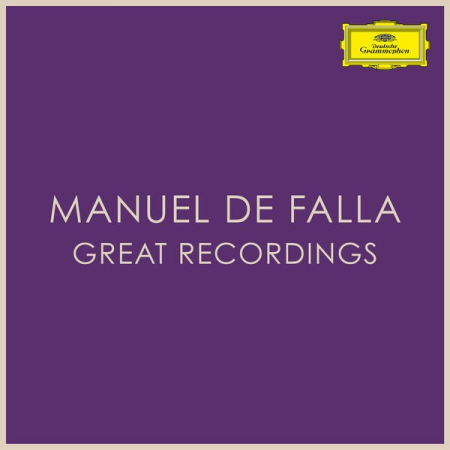VA — Manuel de Falla — Great Recordings (2021)

FLAC (tracks) / MP3 320 kbps | 3h 9 min | Classical | 656 / 440 MB
Part Impressionist, and part neo-Classicist, Manuel de Falla is difficult to peg, but he is widely regarded as the most distinguished Spanish composer of the early twentieth century. His output is small but choice, and revolves largely around music for the stage. Falla\’s reputation is based primarily on two lavishly Iberian ballet scores: El amor brujo (Love, the Magician), from which is drawn the Ritual Fire Dance (a pops favorite, often heard in piano or guitar transcriptions), and the splashy El Sombrero de tres picos (The Three-Cornered Hat). He also gained a permanent place in the concert repertory with his evocative piano concerto, Nights in the Gardens of Spain. Born in 1876,Falla first took piano lessons from his mother in Cádiz, and later moved to Madrid to continue the piano and to study composition with Felipe Pedrell, the musical scholar who had earlier pointed Isaac Albéniz toward Spanish folk music as a source for his compositions. Pedrell interested Falla in Renaissance Spanish church music, folk music, and native opera. The latter two influences are strongly felt in La Vida breve (Life Is Short), an opera (a sort of Spanish Cavalleria rusticana) for which Falla won a prize in 1905, although the work was not prred until 1913. A second significant aesthetic influence resulted from Falla\’s 1907 move to Paris, where he met and fell under the Impressionist spell of Claude Debussy, Paul Dukas, and Maurice Ravel. It was in Paris that he published his first piano pieces and songs. In 1914 Falla was back in Madrid, working on the application of a quasi-Impressionistic idiom to intensely Spanish subjects; El amor brujo drew on Andalusian folk music. Falla wrote another ballet in 1917, El Corregidor y la molinera (The Magistrate and the Miller Girl). Diaghilev persuaded him to expand the score for a ballet by Léonide Massine to be called El sombrero de tres picos, and excerpts from the full score have become a staple of the concert repertory. In between the two ballets came Nights in the Gardens of Spain, a suite of three richly scored impressions for piano and orchestra, again evoking Andalusia. In the 1920s, Falla altered his stylistic direction, coming under the influence of Stravinsky\’s Neo-Classicism. Works from this period include the puppet opera El retablo de Maese Pedro (The Altarpiece of Maese Pedro), based on an episode from Don Quixtote, and a harpsichord concerto, with the folk inspiration now Castilian rather than Andalusian. After 1926 he essentially retired, living first in Mallorca and, from 1939, in Argentina. He was essentially apolitical, but the rise of fascism in Spain contributed to his decision to remain in Latin America after traveling there for a conducting engagement. He spent his final years in the Argentine desert, at work on a giant cantata, Atlántida, which remained unfinished at his death in 1946.
01 Miloš Karadaglić — Falla: Danza del Molinero (\»El Sombrero de Tres Picos\»)
02 José Ramón Encinar — III. Asturiana
03 José Ramón Encinar — I. El paño moruno
04 Alicia de Larrocha — 10. Chanson du feu follet (Arr. Piano)
05 José Ramón Encinar — V. Nana
06 José Ramón Encinar — VI. Canción
07 Andrès Segovia — Le tombeau de Debussy\»
08 José Ramón Encinar — Tempo primo
09 Berliner Philharmoniker — Danza del corregidor
10 Diana Eustrati — Final. Las campanas del amanecer
11 José Ramón Encinar — II. Seguidilla murciana
12 José Ramón Encinar — VII. Polo
13 Berliner Philharmoniker — Danza del molinero
14 José Ramón Encinar — Danza de la molinera. Fandango
15 Mariola Cantarero — \»Abuela, ¡No Viene!\»
16 Berliner Philharmoniker — Introducción y escena
17 Berliner Philharmoniker — En la cueva. La noche
18 José Ramón Encinar — Introducción
19 Diana Eustrati — Canción del amor dolido
20 Berliner Philharmoniker — El aparecido
21 Berliner Philharmoniker — Danza del terror
22 Berliner Philharmoniker — El círculo mágico
23 Berliner Philharmoniker — A media noche. Los sortilegios
24 Berliner Philharmoniker — Escena
25 Diana Eustrati — Canción del fuego fátuo
26 José Ramón Encinar — Danza del molinero. Farruca
27 José Ramón Encinar — Allegretto
28 José Ramón Encinar — Tranquillo
29 José Ramón Encinar — Di nuovo tranquillo
30 José Ramón Encinar — Allegro
31 Diana Eustrati — Danza del juego de amor
32 Alicia de Larrocha — 4. Danza del ritual del fuego fatuo (Arr. Piano)
33 Alicia de Larrocha — 3. Dance of the Miller\’s Wife (Arr. Piano)
34 Alicia de Larrocha — 1. Dance of the Neighbours (Arr. Piano)
35 Coro Nacional De España — \» ¡Ah¡ ¡Ah! / ¡Ande La Tarea, Que Hay Que Trabajar!\»
36 Marina Pardo — \»¡Mi Querer Es Como El Hierro!\»
37 Mariola Cantarero — \»Solo Tengo Dos Cariños\»
38 Mariola Cantarero — \»¡Vivan Los Que Ríen!\»
39 Mariola Cantarero — \»¡Salud!\», \»¿Qué Pasa\»
40 Mariola Cantarero — \»¡Paco!\» \»¡Mi Chavala!\»
41 Coro Nacional De España — Interludio
42 Enrique García Requena — \»¡Olé!\»
43 Mariola Cantarero — \»¡Allí Está!\»
44 Mariola Cantarero — \»¿No Te Dije\»
45 Coro Nacional De España — Danza
46 Mariola Cantarero — \»¡Carmela Mía!\»
47 Mariola Cantarero — \»¡Yo No Vengo A Cantar!\»
48 Miloš Karadaglić — Falla: Homenaje pour le Tombeau de Claude Debussy
49 José Ramón Encinar — IV. Jota
50 José Ramón Encinar — La Tarde
51 José Ramón Encinar — Moderato. Las uvas
52 José Ramón Encinar — Danza de los vecinos
53 José Ramón Encinar — Danza del corregidor
54 José Ramón Encinar — Danza final. Jota
55 Berliner Philharmoniker — Introducción y Danza de la Molinera
56 Berliner Philharmoniker — Danza de los vecinos
57 Berliner Philharmoniker — Danza final
58 Berliner Philharmoniker — Danza ritual del fuego, para ahuyentar los malos espí-
59 Berliner Philharmoniker — Pantomima
60 Gianluca Cascioli — Falla: Danza ritual del fuego







